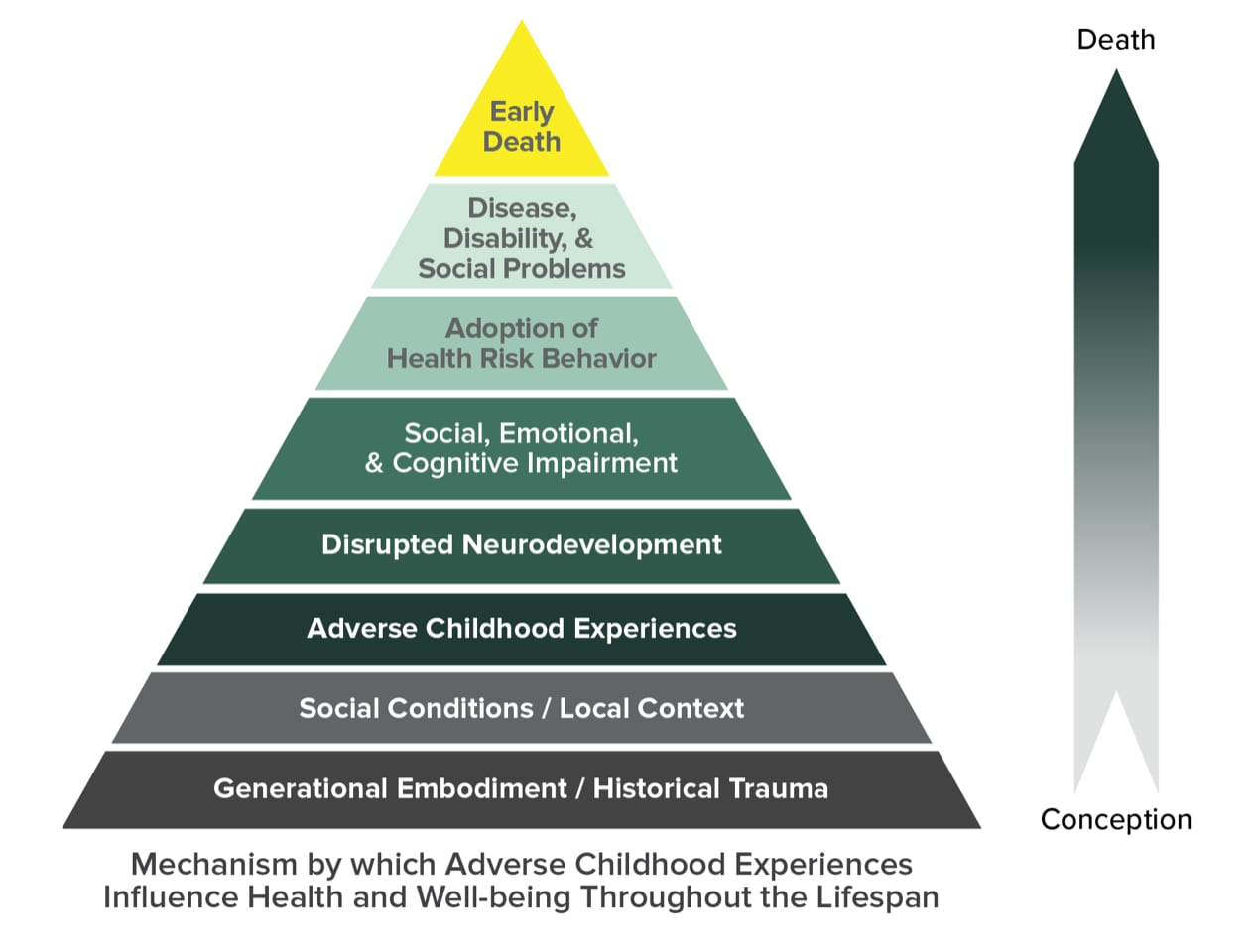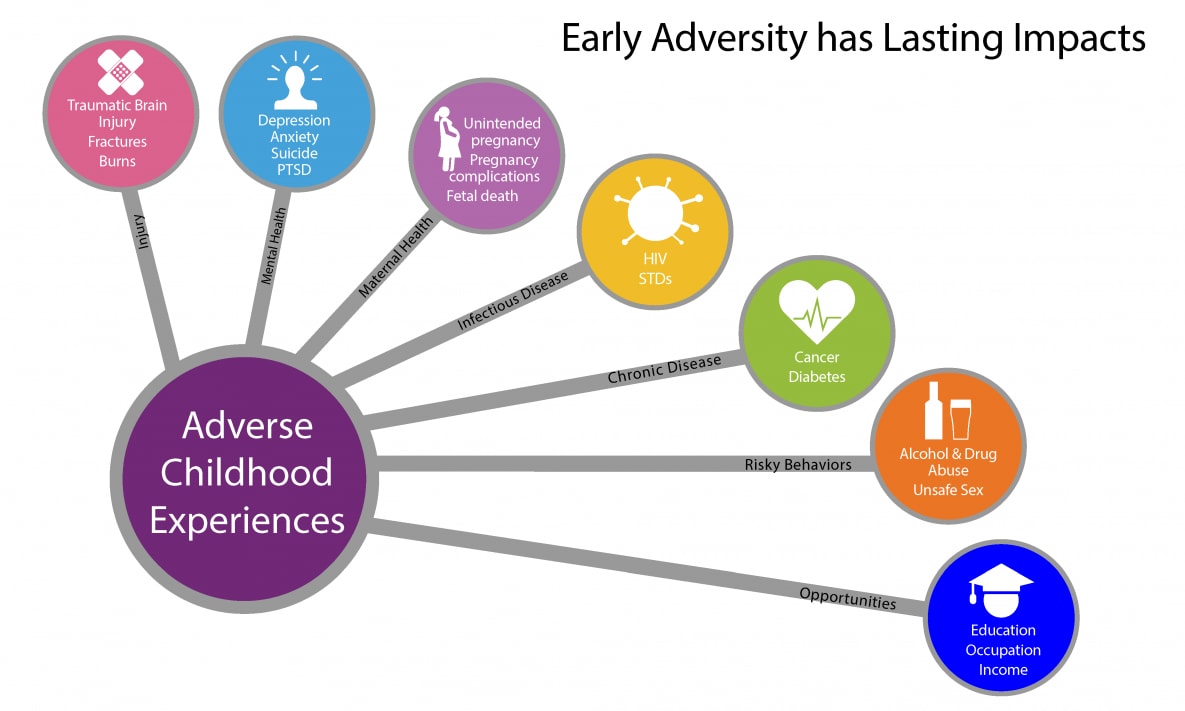About the CDC-Kaiser ACE Study
The CDC-Kaiser Permanente adverse childhood experiences (ACE) study is one of the largest investigations of childhood abuse and neglect and household challenges and later-life health and well-being.
The original ACE study was conducted at Kaiser Permanente from 1995 to 1997 with two waves of data collection. Over 17,000 Health Maintenance Organization members from Southern California receiving physical exams completed confidential surveys regarding their childhood experiences and current health status and behaviors.
More detailed information about the study can be found in the links below or in the article, “Relationship of Childhood Abuse and Household Dysfunction to Many of the Leading Causes of Death in Adults,”.
Please note: The original CDC-Kaiser dataset is not available to the public. Kaiser owns the data and data collection is ongoing (e.g., prescription drug use, medical status of original participants). However, there is an optional ACE Module on the Behavioral Risk Factor Surveillance System (BRFSS) that many states have administered. These data are available for download from BRFSS.
The ACE Pyramid represents the conceptual framework for the ACE Study. The ACE study has uncovered how ACEs are strongly related to development of risk factors for disease, and well-being throughout the life course.

The Family Health History and Health Appraisal questionnaires were used to collect information on child abuse and neglect, household challenges, and other socio-behavioral factors in the original CDC-Kaiser ACE Study. If you would like to receive copies of the questionnaires from the original CDC-Kaiser ACE Study, please email dvpinquiries@cdc.gov.
The questionnaires are not copyrighted, and there are no fees for their use. If you include the ACE Study questionnaires in your research, a copy of the subsequent article(s) is requested (send to dvpinquiries@cdc.gov).
Adverse childhood experiences (ACEs) are categorized into three groups: abuse, neglect, and household challenges. Each category is further divided into multiple subcategories. Participant demographic information is available by sex, race, age, and education. The prevalence of ACEs is organized by category.
ACEs Definitions
All ACE questions refer to the respondent’s first 18 years of life.
- Abuse
- Emotional abuse: A parent, stepparent, or adult living in your home swore at you, insulted you, put you down, or acted in a way that made you afraid that you might be physically hurt.
- Physical abuse: A parent, stepparent, or adult living in your home pushed, grabbed, slapped, threw something at you, or hit you so hard that you had marks or were injured.
- Sexual abuse: An adult, relative, family friend, or stranger who was at least 5 years older than you ever touched or fondled your body in a sexual way, made you touch his/her body in a sexual way, attempted to have any type of sexual intercourse with you.
- Household Challenges
- Mother treated violently: Your mother or stepmother was pushed, grabbed, slapped, had something thrown at her, kicked, bitten, hit with a fist, hit with something hard, repeatedly hit for over at least a few minutes, or ever threatened or hurt by a knife or gun by your father (or stepfather) or mother’s boyfriend.
- Substance abuse in the household: A household member was a problem drinker or alcoholic or a household member used street drugs.
- Mental illness in the household: A household member was depressed or mentally ill or a household member attempted suicide.
- Parental separation or divorce: Your parents were ever separated or divorced.
- Incarcerated household member: A household member went to prison.
- Neglect1
- Emotional neglect: Someone in your family never or rarely helped you feel important or special, you never or rarely felt loved, people in your family never or rarely looked out for each other and felt close to each other, or your family was never or rarely a source of strength and support.2
- Physical neglect: There was never or rarely someone to take care of you, protect you, or take you to the doctor if you needed it2, you didn’t have enough to eat, your parents were too drunk or too high to take care of you, or you had to wear dirty clothes.
1Collected during Wave 2 only.
2Items were reverse scored to reflect the framing of the question.
Participant Demographics
Demographic information is from the entire ACE Study sample (n=17,337).
Demographic Information for CDC-Kaiser ACE Study Participants, Waves 1 and 2. |
||
|---|---|---|
| Demographic Information | Percent (N = 17,337) | |
| Sex | ||
| Female | 54.0% | |
| Male | 46.0% | |
| Race/Ethnicity | ||
| White | 74.8% | |
| Black | 4.5% | |
| Asian/Pacific Islander | 7.2% | |
| Other | 2.3% | |
| Hispanic | 11.2% | |
| Age (years) | ||
| 19-29 | 5.3% | |
| 30-39 | 9.8% | |
| 40-49 | 18.6% | |
| 50-59 | 19.9% | |
| 60 and over | 46.4% | |
| Education | ||
| Not High School Graduate | 7.2% | |
| High School Graduate | 17.6% | |
| Some College | 35.9% | |
| College Graduate or Higher | 39.3% | |
Note: Research papers that use Wave 1 and/or Wave 2 data may contain slightly different reports of participants’ demographic information.
ACEs Prevalence
The prevalence estimates reported below are from the entire ACE Study sample (n=17,337).
Prevalence of ACEs by Category for CDC-Kaiser ACE Study Participants by Sex, Waves 1 and 2. |
|||
|---|---|---|---|
| ACE Category | Women | Men | Total |
| Percent (N = 9,367) | Percent (N = 7,970) | Percent (N = 17,337) | |
| ABUSE | |||
| Emotional Abuse | 13.1% | 7.6% | 10.6% |
| Physical Abuse | 27% | 29.9% | 28.3% |
| Sexual Abuse | 24.7% | 16% | 20.7% |
| HOUSEHOLD CHALLENGES | |||
| Mother Treated Violently | 13.7% | 11.5% | 12.7% |
| Substance Abuse | 29.5% | 23.8% | 26.9% |
| Mental Illness | 23.3% | 14.8% | 19.4% |
| Parental Separation or Divorce | 24.5% | 21.8% | 23.3% |
| Incarcerated Household Member | 5.2% | 4.1% | 4.7% |
| NEGLECT | |||
| Emotional Neglect3 | 16.7% | 12.4% | 14.8% |
| Physical Neglect3 | 9.2% | 10.7% | 9.9% |
Note: 3Collected during Wave 2 only (N=8,629). Research papers that use Wave 1 and/or Wave 2 data may contain slightly different prevalence estimates.
ACE Score Prevalence for CDC-Kaiser ACE Study Participants by Sex, Waves 1 and 2. |
|||
|---|---|---|---|
| Number of Adverse Childhood Experiences (ACE Score) | Women Percent(N = 9,367) |
Men Percent (N = 7,970) |
Total Percent (N = 17,337) |
| 0 | 34.5% | 38.0% | 36.1% |
| 1 | 24.5% | 27.9% | 26.0% |
| 2 | 15.5% | 16.4% | 15.9% |
| 3 | 10.3% | 8.5% | 9.5% |
| 4 or more | 15.2% | 9.2% | 12.5% |
Note: Research papers that use Wave 1 and/or Wave 2 data may contain slightly different prevalence estimates.
Source: Centers for Disease Control and Prevention, Kaiser Permanente. The ACE Study Survey Data [Unpublished Data]. Atlanta, Georgia: U.S. Department of Health and Human Services, Centers for Disease Control and Prevention; 2016.
ACEs are common across all populations. Almost two-thirds of study participants reported at least one ACE, and more than one in five reported three or more ACEs.
Some populations are more vulnerable to experiencing ACEs because of the social and economic conditions in which they live, learn, work and play.
The ACE score is the total sum of the different categories of ACEs reported by participants. Study findings show a graded dose-response relationship between ACEs and negative health and well-being outcomes. In other words, as the number of ACEs increases so does the risk for negative outcomes. For an exhaustive list of outcomes see selected journal publications.
